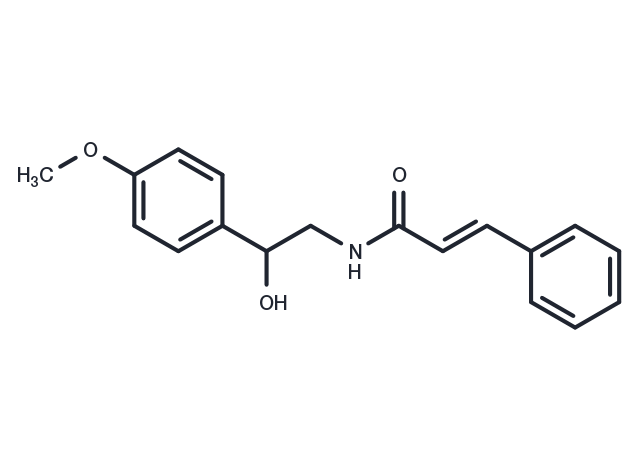Powder: -20°C for 3 years | In solvent: -80°C for 1 year


Aegeline is an alkaloidal-amide, isolated from the leaves of Aegle marmelos and have shown antihyperglycemic as well as antidyslipidemic activities in the validated animal models of type 2 diabetes mellitus.

| Pack Size | Availability | Price/USD | Quantity |
|---|---|---|---|
| 500 mg | In stock | $ 39.00 | |
| 1 mL * 10 mM (in DMSO) | In stock | $ 39.00 |


| Description | Aegeline is an alkaloidal-amide, isolated from the leaves of Aegle marmelos and have shown antihyperglycemic as well as antidyslipidemic activities in the validated animal models of type 2 diabetes mellitus. |
| In vitro | Aegeline enhanced GLUT4 translocation mediated 2-deoxy-glucose uptake in both time and concentration-dependent manner.?2-deoxy-glucose uptake was completely stymied by the transport inhibitors (wortmannin and genistein) in C2C12 myotubes.?Pharmacological inhibition of Akt (also known as protein kinase B) and Ras-related C3 botulinum toxin substrate 1 (Rac1) suggest that both Akt and Rac1 operate aegeline-stimulated glucose transport via distinct parallel pathways.?Moreover, aegeline activates p21 protein-activated kinase 1 (PAK1) and cofilin (an actin polymerization regulator).?Rac1 inhibitor (Rac1 inhib II) and PAK1 inhibitor (IPA-3) completely blocked aegeline-induced phosphorylation of cofilin and p21 protein-activated kinase 1 (PAK1)[1]. |
| Source |
| Molecular Weight | 297.35 |
| Formula | C18H19NO3 |
| CAS No. | 456-12-2 |
Powder: -20°C for 3 years | In solvent: -80°C for 1 year
DMSO: 25 mg/mL (84.07 mM)
You can also refer to dose conversion for different animals. More
bottom
Please see Inhibitor Handling Instructions for more frequently ask questions. Topics include: how to prepare stock solutions, how to store products, and cautions on cell-based assays & animal experiments, etc.
Aegeline 456-12-2 Microbiology/Virology Others Antifungal αsyn yeast Inhibitor protein Sec22p inhibit toxicity Fungal SNARE inhibitor
